Ejection seat
Early models were powered by compressed air and the first aircraft to be fitted with such a system was the Heinkel He 280 prototype jet-engined fighter in 1940.One of the He 280 test pilots, Helmut Schenk, became the first person to escape from a stricken aircraft with an ejection seat on 13 January 1942 after his control surfaces iced up and became inoperative.It had its usual Heinkel HeS 8A turbojets removed, and was towed aloft from the Erprobungsstelle Rechlin central test facility of the Luftwaffe in Germany by a pair of Messerschmitt Bf 110C tugs in a heavy snow-shower.The first test in the air was on a Saab 17 on 27 February 1944,[4] and the first real use occurred by Lt. Bengt Johansson[note 2] on 29 July 1946 after a mid-air collision between a J 21 and a J 22.After World War II, the need for such systems became pressing, as aircraft speeds were getting ever higher, and it was not long before the sound barrier was broken.The United States Army Air Forces experimented with downward-ejecting systems operated by a spring, but it was the work of James Martin and his company Martin-Baker that proved crucial.The first live flight test of the Martin-Baker system took place on 24 July 1946, when fitter Bernard Lynch ejected from a Gloster Meteor Mk III jet.In the early 1960s, deployment of rocket-powered ejection seats designed for use at supersonic speeds began in such planes as the Convair F-106 Delta Dart.Following an accident on 30 July 1966 in the attempted launch of a D-21 drone, two Lockheed M-21[7] crew members ejected at Mach 3.25 at an altitude of 80,000 ft (24,000 m).Despite these records, most ejections occur at fairly low speeds and altitudes, when the pilot can see that there is no hope of regaining aircraft control before impact with the ground.[11] The capabilities of the NPP Zvezda K-36 were unintentionally demonstrated at the Fairford Air Show on 24 July 1993 when the pilots of two MiG-29 fighters ejected after a mid-air collision.Martin Baker added a secondary handle in the front of the seat to allow ejection even when pilots weren't able to reach upwards because of high g-force.The four seats on the forward upper deck (two of them, EWO and Gunner, facing the rear of the airplane) fire upwards as usual.Soviet VTOL naval fighter planes such as the Yakovlev Yak-38 were equipped with ejection seats which were automatically activated during at least some part of the flight envelope.Halfway between simply "bailing out" and using explosive-eject systems, Drag Extraction uses the airflow past the aircraft (or spacecraft) to move the aviator out of the cockpit and away from the stricken craft on a guide rail.In the case of the Space Shuttle, the astronauts would have ridden a long, curved rail, blown by the wind against their bodies, then deployed their chutes after free-falling to a safe altitude.These seats were enclosed in an air-operated clamshell, which permitted the aircrew to escape at airspeeds and altitudes high enough to otherwise cause bodily harm.These seats were designed to allow the pilot to control the plane even with the clamshell closed, and the capsule would float in case of water landings.A zero-zero ejection seat is designed to safely extract upward and land its occupant from a grounded stationary position (i.e., zero altitude and zero airspeed), specifically from aircraft cockpits.The zero-zero capability was developed to help aircrews escape upward from unrecoverable emergencies during low-altitude and/or low-speed flight, as well as ground mishaps.The system is similar to that of a conventional fixed-wing aircraft; however the main rotors are equipped with explosive bolts to jettison the blades moments before the seat is fired, preventing the pilots being gored to death by them.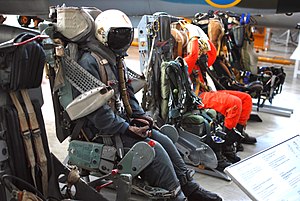
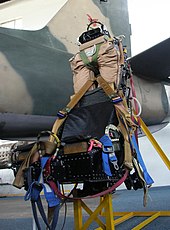




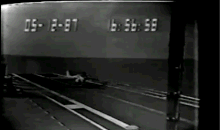
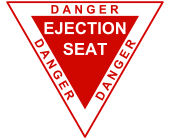

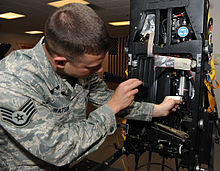

Ejector seat (disambiguation)aircraftrocket motorescape crew capsuleB-58 HustlerparachuteMartin-BakerUnited States Air ForceF-15 Eaglecrash test dummybungeeEverard Calthropparachutescompressed airAnastase DragomirParis-Orly AirportBăneasaBucharestWorld War IIg forcesHeinkelHeinkel He 280jet-enginedfighterArgus As 014V-1 flying bombHeinkel HeS 8Athe Erprobungsstelle Rechlin central test facility of the LuftwaffeMesserschmitt Bf 110Heinkel He 219 UhuBoforsSaab 21Saab 17Heinkel He 162cockpitshotgunDornier Do 335the twin enginespusher propellersound barrierUnited States Army Air ForcesspringJames MartinRAF Museum CosfordGloster Meteor Mk IIIDaily ExpressArmstrong Whitworth A.W.52flying wingrocket propulsionConvair F-102 Delta DaggerEA-6B ProwlerUSS John C. StennisConvair F-106 Delta DartCanberraD-21 droneLockheed M-21Mach 3.25U.S. NavyRogallo winggyrocopterKaman AircraftFairchild HillerA-4E SkyhawkUSS Shangri-LaCompression fracturesProject WhooshchimpanzeeNPP Zvezda K-36Fairford Air ShowMiG-29NPP ZvezdaRoyal NavyFleet Air ArmACES IIMountain Home AFBB-52 StratofortressCrew CapsuleF-104 StarfighterT-tailcenter of gravityBAE HawkHarrierHawker Siddeley HarrierT-6 Texan IIF-35 Lightning IIshell toothpolycarbonateYakovlev Yak-38escape capsuleB-70 ValkyrieGeneral Dynamics F-111capsuleairbagaltitudeairspeedimpulseKamov Ka-50helicopterrotorsexplosive boltsTupolev Tu-144Tu-144 that crashed at the Paris Air Show in 1973Lunar Landing Research VehicleNeil ArmstrongVostokGeminiSpace ShuttleColumbiaEnterpriseSpace Shuttle orbitersBuran-class orbitersAston Martin DB5James Bond filmsG-seatAttacks on parachutistsCaterpillar ClubDynamic response indexEscape podLaunch escape systemAirborne lifeboatLifeboatPressure suitNaval Historical CenterAir Force Missile Development CenterHolloman Air Force BaseBharat Rakshak
